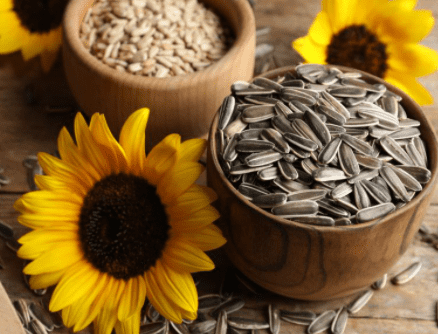Gardening is a great way to connect with nature and bring beauty into your life. Sunflowers have been a source of delight for gardeners, who are often mesmerized by their vibrant yellow petals that follow the sun.

But have you ever wondered what it takes to produce these cheerful blooms? In this article, we’ll take you through the 8 sunflower growing stages and discuss how to care for them.
So grab your gardening gloves and get ready to learn how to grow these captivating flowers!
Stage 1: Plant sunflowers.
The first step in growing sunflowers is planting the seed.
Sunflower seeds should be planted in an area with plenty of sunlight, ideally when the soil temperature is between 65-70 degrees Fahrenheit.
Plant seeds by adding a thin layer of soil on top and keep the soil moist.
Depending on the variety, sunflowers can grow anywhere from 2 feet tall to 12 feet tall, so plan accordingly!
Dwarf varieties are ideal for small gardens or containers and can reach heights of 1-2 feet tall.
When selecting your variety, also consider the annual or perennial nature of your sunflower – annuals will need to be replanted each year, while perennials will continue to bloom year after year.
Stage 2: Sunflower Seed Germination
The next stage in the sunflower growing process is seed germination.
Sunflower seeds usually sprout in 7-10 days, but it depends on the variety, soil temp. and seed depth.
Seed coat breaks and roots appear.
The root grows down, and the stem grows up.
Once it’s securely anchored in place, leaves will begin to develop and true leaves will start to appear.
During this time, keep an eye out for any signs of pests or insects such as sunflower moths which can damage your plants and reduce yields.
Make sure to water regularly so that your soil stays moist but not wet – too much moisture could cause your seedlings to rot before they even have a chance to bloom!
Step 3: Seedling of Sunflower
Once your sunflower seedlings have grown large enough and developed true leaves, they will enter the third stage of growth: the seedling stage.
During this time, the plants need plenty of sunshine and nutrients to grow strong and healthy.
You should water them regularly, but be careful not to overwater them as this can cause root rot.
Sunflowers prefer soil temperatures between 65-85°F (18-29°C), so make sure you are monitoring your soil temperature closely during this stage.
As the seedlings get bigger, you may also want to thin out some of the weaker plants so that the remaining ones have enough space and resources for growth.
Lastly, if you are growing a dwarf variety of sunflowers that are only supposed to reach a few inches tall, then be sure to pay attention to their height throughout this process so that you don’t let them get too big!
Stage 4: Growing a Bud
In the fourth stage, your sunflower will begin to produce a bud.
This is a very important stage as it signals that the plant is mature enough and ready to flower.
You will know that your sunflower is in this stage when you start to see buds forming at the top of the stem.
During this time, make sure your sunflower receives plenty of sunlight and water. It’s best to water your sunflower at least once per day, but if you live in an area with hot summers or little rain, then you may need to water more often.
Additionally, if you are growing a variety of sunflower that normally grows tall (such as Helianthus annuus), be sure to provide support so that they don’t topple over in heavy winds or rainstorms.
With proper care and attention during this stage, you should be able to enjoy beautiful blossoms soon!
Stage 5: Flowering of Sunflower
Stage 5: Flowering is the time when your sunflowers will be in full bloom and you can enjoy their beauty.

During this stage, the fully grown yellow flowers will open up and last for a few days to a week before wilting.
At this time, it’s important to provide your sunflowers with plenty of sunshine to ensure that they last as long as possible.
Additionally, you should continue watering them regularly and make sure there is no soil compaction around their roots.
If you are growing an annual variety of sunflower (Helianthus annuus), then you may also need to keep an eye out for the Sunflower Moth which may lay eggs on the flower petals and feed on the pollen.
With proper care, you can enjoy beautiful blooms for weeks or even months!
Stage 6: Sunflower Pollination
Stage 6: Sunflower Pollination is the process of transferring pollen from the male stamen to the female pistil of a sunflower flower.
During this stage, bees, butterflies, and other insects will visit your sunflowers and collect pollen from the anthers.
This process is essential for proper fertilization of the ovules to produce edible seeds or fruit.
North American varieties of sunflowers tend to be more pollinator-friendly than dwarf varieties as they are known to produce larger flowers that are easier for pollinators to access.
As you prepare your plants for this stage, it’s important to make sure that the soil temperature is warm enough (over 65°F) so that the flowers can open up properly and attract pollinators.
If done correctly, you should be able to enjoy a successful harvest!
Stage 7: Seed development
Stage 7: Seed Development is the process by which sunflower seeds are produced.
After pollination has taken place, the female pistil of the flower will swell and begin to form a fruit that contains two seeds.
This fruit is known as achene and the seed inside of it is called a caryopsis.
As the fruit matures, its outer walls harden and the seed coat develops around it.
Sunflower seeds contain high levels of oil and protein, making them a valuable source of food for humans and animals alike.
To ensure maximum yield from your sunflowers, it’s important to make sure that your plants receive adequate amounts of sunlight throughout this stage to promote healthy seed development.
If done correctly, you should be able to enjoy a successful harvest!
Stage 8: Harvesting Sunflower
Stage 8: Harvesting Sunflower is the final stage of sunflower growth.
At this point, the hard work you have put into caring for your sunflower plants will finally pay off! To harvest your sunflowers, wait until your flowers have started to turn dry and yellow.
Then, cut off each head at the base using sharp shears or a knife. Next, hang them upside down in a cool, dark location for about a week for the seeds to fully dry out.
Finally, remove the seeds from each flower head and store them in an airtight container.
With proper care during its growing stages, your sunflowers should now yield plenty of delicious edible seeds that can be used in recipes or as snacks throughout the year!
Conclusion
Sunflowers are an incredibly popular and beautiful addition to any garden. With proper care and nurturing, sunflowers can grow up to 8 feet tall and produce a large number of edible seeds.
There are many varieties of sunflowers available for planting in North America, from dwarf varieties that only reach 1-2 feet tall to giant varieties that can reach over 8 feet tall.
They thrive best in well-drained soil with a temperature between 18°C (65°F) and 26°C (80°F). Once planted, the sunflower seedlings will typically take around 45 days to reach maturity.
During their growth stages, it is important to provide them with adequate water and sunlight so that they develop true leaves and have enough energy to produce a healthy harvest of edible seeds.
With the right amount of dedication and care, you’ll be able to enjoy the beauty of your sunflower plants as well as savor their delicious bounty!






